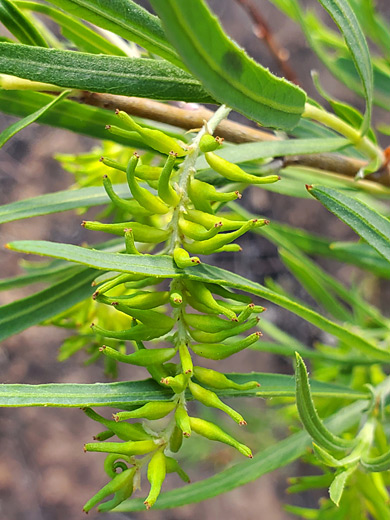Common names:
Sandbar willow, coyote willow
Family:
Scientific name:
Salix exigua
Main flower color:
Range:
All of the western states apart from Kansas
Height:
Up to 15 feet
Habitat:
Riverbanks, lakeshores, sandbars, other riparian places; up to 9,000 feet
Leaves:
Linear, up to 6 inches long and 0.5 inches wide, on stalks of around 0.3 inches, with toothed margins and hairy undersides
Season:
March to September
Salix exigua is a common species of riparian areas in the West, often forming dense thickets, along river banks and in wet canyons. It usually reaches heights of 15 feet but can be up to three times this. New branches are reddish, covered with fine pubescence, sometimes with longer hairs, while older branches are grey and hairless. Leaves are linear, and narrow; up to 25 times as long as wide, entire towards the base and lined with small, well-separated teeth towards the tip. Lower leaf surfaces are hairy, the upper sides generally glabrous.
The inflorescence appears with or after the leaves. Staminate flowers, in a catkin up to 2 inches long, have hairy filaments and yellow or reddish anthers, while pistillate flowers have spreading, yellowish-green carpels, toped by tiny stigmas, in a catkin of up to 3 inches.
Plants in most regions are var exigua; the less common var hindsiana is found at lower elevations in California and Oregon, and is distinguished by characteristics of the pubescence.
The inflorescence appears with or after the leaves. Staminate flowers, in a catkin up to 2 inches long, have hairy filaments and yellow or reddish anthers, while pistillate flowers have spreading, yellowish-green carpels, toped by tiny stigmas, in a catkin of up to 3 inches.
Plants in most regions are var exigua; the less common var hindsiana is found at lower elevations in California and Oregon, and is distinguished by characteristics of the pubescence.
All Contents © Copyright The American Southwest | Comments and Questions | Contribute | Site Map



